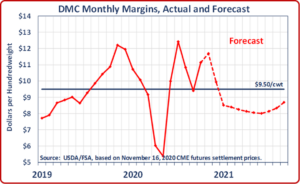A bitter election season is winding down, and the shape of the Biden Administration and Congress is becoming clear. Just as clear is another political reality: Washington next year will be, if anything, more closely divided than it was before.
That places bipartisanship at a premium, as any lasting solutions to policy challenges will require cooperation from both sides of the aisle. Fortunately, dairy is well-situated to play an important role in the agreements that will be necessary to get anything done in Washington, as evidenced by the many bipartisan policy gains that bore fruit for dairy in 2020.
Consider this. At the beginning of this year, dairy prices were projected at levels sufficient to keep income-over-feed-costs margins high enough to avoid triggering payments under the Dairy Margin Coverage Program. Instead, as the coronavirus crisis seized the nation beginning in March, prices plunged, leading to emergency-milk dumping and triggering about $200 million in payments to producers who enrolled in DMC.
That assistance came about because of the 2018 farm bill, passed with the support of both parties and including a revamp of dairy risk management tools that literally paid off at an incredibly crucial time. Signup for DMC coverage in 2021 is open until Dec. 11, and with payouts projected for the first eight months of the year, it’s important that farmers take advantage of this important program. Doing so directly delivers the benefits of effective bipartisan policymaking to the farm.
On top of DMC assistance, bipartisan cooperation yielded several benefits to dairy this year that have proven crucial to farmers’ economic health. The Coronavirus Food Assistance Program (the latest round of which also has a Dec. 11 signup deadline) bolstered many farmers’ cash flows, with two rounds of payments providing disaster assistance averaging as high as $2.47 per cwt for all milk marketed in 2020 and softening the blows of pandemic disruptions for many farm families. In tandem with CFAP, the Farmers to Families Food Box program has fed those in need and kept processors in business, benefiting communities, preserving jobs and ensuring that farmers have supply chains to serve.
NMPF also helped ensure that programs implemented for small businesses nationwide worked for dairy. The Paycheck Protection Program (PPP) and COVID-19 Economic Injury Disaster Loans (EIDLs), two coronavirus-related rescue measures implemented by the Small Business Administration (SBA), initially evolved from a hope to a frustration for dairy producers, who didn’t have equitable access to the programs. Working with allies, members of Congress from both parties, and administration officials, NMPF rectified many of the hurdles to the programs, increasing dairy’s access to the small business support as the SBA programs continued.
This more than $5 billion infusion of federal aid, and ongoing improvements in their administration, has been a difference-maker for dairies across the nation. Albeit, not all our farmers received the same level of support due to issues including payment limitations, organizational structures or market volatility. Nevertheless, in a telling statistic, the pace of dairy farm consolidation appears to be slowing this year – this is counterintuitive given the disruptions farms have faced, but a tribute to the effective efforts made to help farmers weather these storms.
All of it has been the product of fruitful collaboration, from within the dairy community as we at the National Milk Producers Federation and cooperatives and dairy associations across the country together pursued policy goals, to Capitol Hill, where champions in both parties spoke out on the need for dairy initiatives, and in the administration, which implemented programs funded by a Democratic House of Representatives and a Republican Senate for the betterment of dairy.
We’ve also fostered bipartisan collaboration on trade, with lawmakers from both parties calling for action against protectionist EU practices that inhibit dairy-export growth and defending the use of common cheese names. And we’ve worked for bipartisan agreement on immigration – a promising package passed in the House nearly one year ago stalled in the Senate as coronavirus demanded attention, but renewed efforts are expected in the next Congress.
In the near term, we remain hopeful that Congress may pass another COVID-19 relief package this month, given the acute strains our health-care systems and economy are facing now and for at least the next several months. Times of crisis demand unity – and despite the tendency toward reflective naysaying about Washington, consensus is possible to achieve, as the gains of the past year have shown. NMPF is advocating for additional relief for dairy producers that reflects the losses they have suffered, no matter the size of an operation. We are also urging Congress to approve a dairy donation program that can maximize dairy consumption among food-insecure populations.
In 2021 NMPF will continue its work as an advocate for dairy producers and their cooperatives in policy decisions, with our hallmark bipartisanship giving us a seat at the table wherever, whenever, and with whomever is making important decisions affecting farmer livelihoods.








